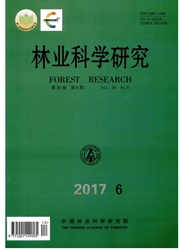

 中文摘要:
中文摘要:
采用ISSR分子标记技术对茶花品种群中有代表性的20个国内外茶花品种进行了品种间遗传关系的分析。从60对随机扩增引物中筛选出了21对扩增带型清晰及重复性好的引物序列,共扩增出153条带,其中146条呈现多态性,多态性条带比例为95.4%;Nei's基因多样性指数介于0.40-0.48,Shannon信息指数在0.57-0.67,基因分化系数介于0.5-0.7,基因流值介于0.2-0.5,遗传相似系数介于0.50-0.74,平均为0.63。参试的20个茶花栽培品种间遗传差异相对比较窄;结合花型形态学特征与UPGMA聚类分析结果,可将20个茶花品种分为2个大类群。此外,结果显示:ISSR分子标记适用于分析山茶品种间遗传多样性和亲缘关系。
 英文摘要:
英文摘要:
Camellia japonica has various ecological, horticultural and economical uses. An approach was established using ISSR (Inter-simple sequence repeat ) molecular makers to classify and analyze the intra-specific genetic relationship among twenty cuhivars represented from C. japonica, collected in China and abroad. Twenty-one couples of primer sequences which could amplify clearly and reproducible electrophoresis bands were screened from sixty couples of primers. Using these primers, 153 discernible DNA fragment were generated with 146 (95.4%) being polymorphic, indicating pronounced genetic variation at the cuhivars level; the band in fingerprinting were converted into "0" or "1 ", where "1"and "0" indicated the presence and absence of a band, respectively. Nei's diversity indices (H) ranged from 0.40 to 0.48 and Shannon' s information index (I) ranged from 0.57 to 0.67. The gene differentiation coefficients ranged from 0.5 to 0.7 and Nm ranged from 0.2 to 0.5. The genetic similarity coefficients (Hs) among the tested cuhivars ranged from 0.50 to 0.74, averaging 0.63. The results showed that the genetic differences among the twenty cultivars were relatively little. Combing the results of flower morphology and UPGMA cluster analysis, we could divide the twenty cultivars into two big groups. There were four cultivars in group I , which all grows in Zhejiang Province and has red flowers. There were sixteen cuhivars in group 11 , intraspecific genetic relationship complexity. In addition, the results also showed that ISSR molecular maker was suitable to analyze the intra-specific genetic diversities and genetic relationships of C. japonica.
 同期刊论文项目
同期刊论文项目
 同项目期刊论文
同项目期刊论文
 Preparation of Aminated Macroporous Polyvinyl Alcohol Resins and Evaluation for Bilirubin Adsorption
Preparation of Aminated Macroporous Polyvinyl Alcohol Resins and Evaluation for Bilirubin Adsorption Preparation of Aminated Macroporous Polyvinyl Alcohol Resins and Evaluation for Bilirubin Adsorption
Preparation of Aminated Macroporous Polyvinyl Alcohol Resins and Evaluation for Bilirubin Adsorption 期刊信息
期刊信息
